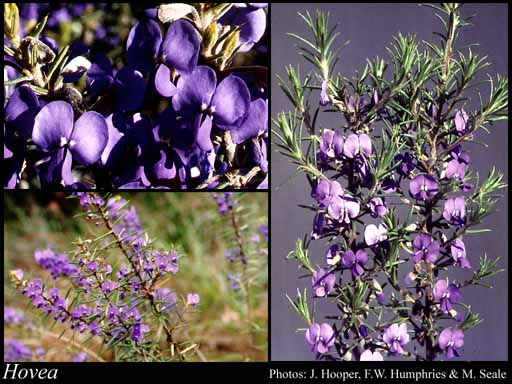- Reference
- Hort.Kew. [W. Aiton] 4:275 (1812)
- Name Status
- Current

Scientific Description
Family Papilionaceae. Bossiaeae.
Habit and leaf form. Shrubs (or subshrubs). Leaves well developed. Plants prickly (leaf margins), or spiny, or unarmed (usually). Mesophytic, or xerophytic. Leaves minute to medium-sized; alternate; spiral, or distichous; leathery; petiolate to sessile; non-sheathing; simple; pulvinate. Leaf blades dorsiventral; dissected, or entire; sometimes prickle-lobed pinnatifid; cross-venulate. Leaves with stipules, or without stipules. Stipules intrapetiolar; often subulate to spiny. Leaf blade margins entire, or serrate; prickly (e.g. H. chorizemifolia), or not prickly. Leaves without a persistent basal meristem. Stem anatomy. Secondary thickening developing from a conventional cambial ring.
Reproductive type, pollination. Fertile flowers hermaphrodite. Unisexual flowers absent. Plants hermaphrodite. Entomophilous, or ornithophilous. Pollination mechanism conspicuously specialized.
Inflorescence and flower features. Flowers solitary, or aggregated in ‘inflorescences’ (usually); when solitary, axillary; in racemes, or in fascicles. Inflorescences simple, or compound. The terminal inflorescence unit cymose, or racemose. Inflorescences terminal, or axillary. Flowers pedicellate; bracteate; (bi-) bracteolate. Bracteoles not adnate to the receptacle (on the upper part of the pedicel). Flowers minute to medium-sized; very irregular; zygomorphic. The floral asymmetry involving the perianth, or involving the perianth and involving the androecium. Flowers papilionaceous (imbricate-descending, with the posterior petal outside and forming a flag (‘standard’)); basically 5 merous. Floral receptacle developing a gynophore, or with neither androphore nor gynophore. Free hypanthium present, or absent. Perianth with distinct calyx and corolla; 10; 2 -whorled; isomerous. Calyx present; 5; 1 -whorled; gamosepalous; (4–5) lobed. Calyx lobes about the same length as the tube, or markedly longer than the tube. Calyx imbricate, or valvate; exceeded by the corolla; strongly bilabiate (the two posterior lobes or teeth connate into a truncate or emarginate upper lip, the other three shorter and narrow); persistent; with the median member anterior. Epicalyx absent. Corolla present; 5; 1 -whorled; appendiculate, or not appendiculate. Standard not appendaged. Corolla partially gamopetalous. 2 of the petals joined (the two ventral petals connivent to form the ‘keel’). The joined petals of the papilionate corolla anterior. The wings of the corolla free from the keel; not laterally spurred. Standard ‘normally’ developed (suborbicular); emarginate (to bilobed). Keel conspicuously exceeded by the wings (and curved); not long-acuminate/beaked; neither coiled nor spiralled; not bent and beaked. Corolla imbricate (descending); plain (the standard with a white or yellow ‘eye’); purple, or blue (exclusive of markings); persistent, or deciduous. Petals clawed. Androecial members definite in number. Androecium 10. Androecial sequence determinable, or not determinable. Androecial members free of the perianth; all equal to markedly unequal (only a slight tendency to long and short alternation); coherent (into an adaxially or adaxially and abaxially split sheath); 1 - adelphous, or 2 - adelphous, or 4 - adelphous (the vexillary and/or a lower one sometimes free). The staminal tube free from the keel petals. Androecial members 1 -whorled (even though diplostemonous). Androecium exclusively of fertile stamens. Stamens 10; distinctly dissimilar in shape (alternately dorsifixed and basifixed); diplostemonous; both opposite and alternating with the corolla members. Anthers separate from one another, or connivent; dimorphic; alternately dorsifixed and basifixed; versatile, or non-versatile; dehiscing via longitudinal slits; latrorse, or introrse; tetrasporangiate. Pollen shed as single grains. Gynoecium 1 carpelled. The pistil 1 celled. Carpels reduced in number relative to the perianth. Gynoecium monomerous; of one carpel; superior. Carpel stylate; apically stigmatic. Style (in-) curved. Style glabrous. Stigmatic tissue terminal. Carpel 2–3 ovuled (rarely ‘to many’?). Placentation marginal (along the ventral suture). Gynoecium median (the placenta posterior, on the ventral suture). Ovary sessile to stipitate. Ovules pendulous to ascending; biseriate; arillate; anatropous, or campylotropous to amphitropous, or hemianatropous.
Fruit and seed features. Fruit aerial; stipitate to sessile; non-fleshy; hairy, or not hairy. The fruiting carpel dehiscent; a legume. Pods globose to somewhat elongated (broader than long to scarcely longer than broad, obliquely subglobose or rhomboid-ovoid); not triangular; not transversely septate; wingless. Valves of the dehisced pod not twisted. Fruit 1 celled. Dispersal unit the seed. Seeds endospermic, or non-endospermic; not mucous; compressed, or not compressed; small to medium sized; arillate (the aril collarlike, or much longer than broad). Cotyledons 2. Embryo straight (the radicle straight). Testa non-operculate. Micropyle zigzag, or not zigzag.
Physiology, biochemistry. Aluminium accumulation not found. Photosynthetic pathway: C3.
Geography, cytology, number of species. Native of Australia. Endemic to Australia. Australian states and territories: Western Australia, Queensland, New South Wales, Victoria, Australian Capital Territory, and Tasmania. Eremaean Botanical Province and South-West Botanical Province. 2n=18. A genus of 12 species; 8 species in Western Australia.